- Create
- Market
- Scale
create
market
The All In One Marketing Platform
Selling online courses is a lucrative opportunity for content creators, career educators, and field experts who wish to monetize their knowledge. Online courses are incredibly versatile digital products — able to be marketed as lead magnets, standalone products, or membership experiences. They can be as simple or complex as you want, ranging from evergreen video tutorials to live events for cohorts of students.
But how do you turn your idea into an online business that actually makes money? Find out by following this step-by-step guide on how to sell online courses:
Before you do anything else, it’s imperative to start with the specific purpose you want your course to fulfill. There are a variety of ways for an online course to drive revenue. Courses can be…
The purpose of an online course drives both the content and the sales strategy. It should determine everything from the course topic to digital marketing tactics.
For example, some courses are sold as high-value, high-ticket experiences. The course creator won’t need thousands of sales to make a profit, just a few eager students who will be excited to give referrals to their network. However, the course will need to meet expectations and deliver significant value for the audience. Other online courses are low-cost, low-commitment digital products meant to raise brand awareness and build trust. This type of course can be more basic, but needs a significant number of sign-ups to accomplish its purpose.
Chances are, you have a few great course ideas you’re thinking about. To narrow in on the perfect course topic, ask these three questions:
It’s difficult to find success if any one of these elements is missing. For instance, there might be a topic that takes advantage of your expertise and is relevant to your audience, but it’s too basic to sell at a premium price. It won’t fulfill its purpose.
Conducting competitor research and audience research is crucial in this stage. Learn what resources already exist and analyze how you can bring something new to the table. Test topic ideas through surveys and quizzes if you have an existing email list or social media following. Some course creators even pre-sell their courses to validate their ideas and ensure they’ll have an engaged audience.
Your value proposition clearly states what your course does and for whom. While similar to the course topic and the course goal, the value proposition goes a step further. It requires you to know exactly who you want to teach and what your course will accomplish in your students’ lives. The value proposition is the selling point of your course. It’s what sets you apart from competitors and determines the quality of your course.
Whether your course is simple and straightforward or involves a complex assortment of content types, you’ll want to approach online course creation with an eye toward your sales and marketing plan. Keep in mind how you can repurpose parts of your course to serve as lead magnets, giveaways, teasers, or other promotional content.
For example, the course’s introductory lesson could be repurposed as teaser content for your social media accounts or offered as a downloadable course sample on your website. It takes a lot of work to develop course modules, so take advantage of every opportunity to leverage the content you’re already creating. Forward-thinking will make marketing and selling the course a lot easier down the road!
How your course is packaged and priced is a significant part of your sales strategy. Not only is pricing about creating a profitable online course, but your choice will influence brand perception, the student experience, and marketing success.
Here are several pricing models for course creators:
As you hone in on the price and pricing model, remember to go back to the course’s purpose. What do you need it to accomplish for your brand? What is it going to accomplish for your students? Conduct market research to analyze competitor pricing and do in-depth audience research to judge how much students will be willing to pay for your course. And always remember that the price of your online course needs to accurately reflect its value.
Want to avoid overpromising or underselling your course? Check out this guide on how to price an online course.
To make real money from an online course, the best place to sell it is your own website. Selling courses on your website gives you exclusive ownership of your products and your audience — allowing you to take home the profits and build a scalable brand.
Course creators will need a membership site platform, or online course platform, that gates course content behind a paywall. Examples include Kartra, Kajabi, Thinkific, Teachable, and Podia. With intuitive membership software, it’s easy to upload video content, ebooks, downloadable PDFs, and any other course materials. You can even set membership tiers where paying customers only get access to the course materials that belong to their plan.
An effective course sales page facilitates the sale, giving interested students the information they need to make a purchase decision. The page should walk potential customers through the benefits of your course, what to expect, and where to sign up. Be sure to include social proof for added credibility — such as reviews, testimonials, or success stories. This dedicated landing page will be the foundation of your sales funnel!
A “sales funnel” simply refers to the multiple stages that prospects go through before they make a purchase decision. First, they have to become aware of your brand (top of the funnel), then prospects develop an interest in your brand (middle of the funnel), and finally, they decide they need your product or service (bottom of the funnel).
Course creators need to align their marketing and sales strategies with each stage of the funnel. Map out the buyer journey your ideal customer will take, from discovery to decision. Identify your audience’s values, needs, pain points, possible objections, gaps in information, and anything else that plays a role in their purchase decision. Your sales and marketing efforts should be aligned with this research — meeting your audience where they are and giving them all the information they need to purchase from you.
Top of funnel: A life coach posts teaser videos of course material to raise awareness. Each post is linked to a dedicated landing page about the course.
Middle of funnel: As interested prospects visit the coach’s website, a pop-up form offers the first full lesson as a freebie in exchange for their email address.
Bottom of funnel: Everyone who signs up for the free lesson receives an automated email sequence with information about the course along with student testimonials. The sequence ends with a discount code and a CTA to sign up for the course on the sales page.
Unless you’ve already amassed a brand following, the initial stage of the sales funnel can be intimidating. How do you get an audience to notice your first online course? The best marketing strategies for your specific course will depend on numerous factors — including the course price, the audience’s values and needs, and your budget.
Here are a few course promotional tactics to consider:
Remember to focus on the quality of your leads and not the quantity. Based on the predicted conversion rate, determine your ideal number of purchases per month and then how many leads you’ll need to get those purchases. Pour your efforts into getting just those leads. Not everyone needs to know about your course — just your target audience!
Develop a holistic marketing plan with our guide: Everything You Need to Know to Market Your Online Course.
There are three main types of course publishing platforms in the e-learning world: independent membership sites, online course marketplaces, and learning management systems. Membership websites give content creators the most control over their products, but it’s important to understand the purposes of alternative platforms:
A massive open online course (MOOC) is a course marketplace that educates large numbers of online students on a wide range of subjects. Not intended for independent course creators, a MOOC (such as Udemy or Skillshare) is its own platform with its own member base. Educators upload either paid or free courses to these platforms for online learners to access.
A learning management system (LMS) is used primarily by schools or businesses to facilitate online classwork and training programs. It integrates more administrative tools than an online course platform and is not intended for independent course creators. Popular learning management systems include Canvas, Google Classroom, and WordPress LMS plugins like Learndash.
Kartra is the best online course software for content creators. This all-in-one membership and marketing platform gives you all the tools you need to build and sell a successful online course in a single subscription. Key Kartra features for creators include:
A comprehensive platform like Kartra means you don’t have to stitch together multiple software subscriptions to sell your course. Instead, you can publish the materials, manage students, and market your course from the same place. Kartra empowers you to deliver a professional online learning experience — and gives you all the marketing tools you need to scale your course business!
You’ve landed on the perfect course topic, and it’s time to share your knowledge with the world. But how do you know what to charge for it? There is no one-size-fits-all answer to this question, but it comes down to four main considerations: the course’s value, purpose, costs, and structure. Once you factor in each of these elements, you’ll be able to set the right price for anything from mini-courses to masterclasses.
The single biggest determining factor in the price of your course is how much value it actually delivers to your students. The value of your course might be estimable (like learning how to earn money from rental properties) — or maybe it’s intangible (like learning a new skill).
Here are some examples of the value that a course can deliver:
The keys here are impact and exclusivity. The more significant the results — and the harder it is to get those results through any other means besides your course — the more your course is worth. It’s easy for online course creators to undersell their knowledge, especially the first time around. Factor in how much training and experience went into your product and consider what your course will accomplish in the lives of your students.
Before you get too deep into online course pricing strategies, revisit the original purpose and revenue goals behind your course idea. The sweet spot of course pricing is the number that accurately reflects the value of the course to learners while achieving the course creator’s revenue goals.
A course that acts as a lead magnet would need to be priced (or given away) so that it attracts your ideal number of leads. It won’t necessarily make money on its own. But if you want to sell your course as a standalone digital product that drives passive income, it will need either a significant price point or a significant number of buyers (or both).
It’s important to know your ideal revenue goal so that you can adjust pricing and marketing strategies accordingly. Breaking down revenue goals into exact numbers will help you understand the concrete steps necessary for success.
Expected Conversion Rate: 10%
Option A: Sell the course for $100 to 100 customers (requires 1,000 leads)
Option B: Sell the course for $250 to 40 customers (requires 400 leads)
Option C: Sell the course for $1000 to 10 customers (requires 100 leads)
The costs of producing and marketing your course easily build up without you realizing it – especially as you add more students and scale your business. Make sure you don’t get so busy delivering content that you fail to revisit the numbers! Set aside time to re-evaluate course costs and ensure your business is operating on the correct premises.
Developing a course involves a variety of expenses – from the video equipment you use for filming lectures to the software that lets you upload, edit, and publish content. Expenses related to working with third-party vendors such as website designers or video editors also fall under the cost of course creation. As your course offerings grow, these expenses will likely increase.
Getting your course into the hands of students creates its own category of expenses. Shipping costs for course materials, membership management software, email automation software, and other aspects of course delivery quickly add up! Take inventory of each step you take to publish course content and itemize the costs involved.
Your customer acquisition cost (CAC) is the average expense you incur to convert a potential student into a paying member. If you haven’t sold your first online course yet, you will need to make educated guesses about your budget and then adjust the numbers as you gather data.
Customer acquisition costs include all sales and marketing expenses such as advertising, discounts, or sales tools. Comparing your customer acquisition cost (CAC) to the customer lifetime value (LTV) helps you understand the profit you get from each new client based on your current methods for obtaining clients. (Customer lifetime value is the revenue you receive from someone over the whole length of time they are an active customer.)
The pricing model is how you package and deliver your online course. Can students buy the course for a one-time fee? Do they pay for an ongoing subscription or membership? Can they choose between various packages? There are a wide variety of models to choose from that include:
Consider your target audience and their needs, as well as your level of ongoing involvement and income goals. For example, a fixed price model is a simple option for evergreen content — but it runs on one-time purchases. You’ll have to consistently generate new leads to keep making money. Offering a membership or subscription is a great way to create a consistent income stream, but you’ll have to regularly release new material to make it worth your students’ investment.
If you’re worried about sales, it’s easy to fall back on the idea that lower prices will attract more customers. While this can be true in some situations, many consumers actually associate higher prices with higher value and would rather pay more for a better product. However, that high price can backfire if students don’t feel they received a premium experience.
Ultimately, people want to believe that a product or service is worth their money. Overpricing and underpricing both discourage sales in different ways — one by overpromising and the other by underselling.
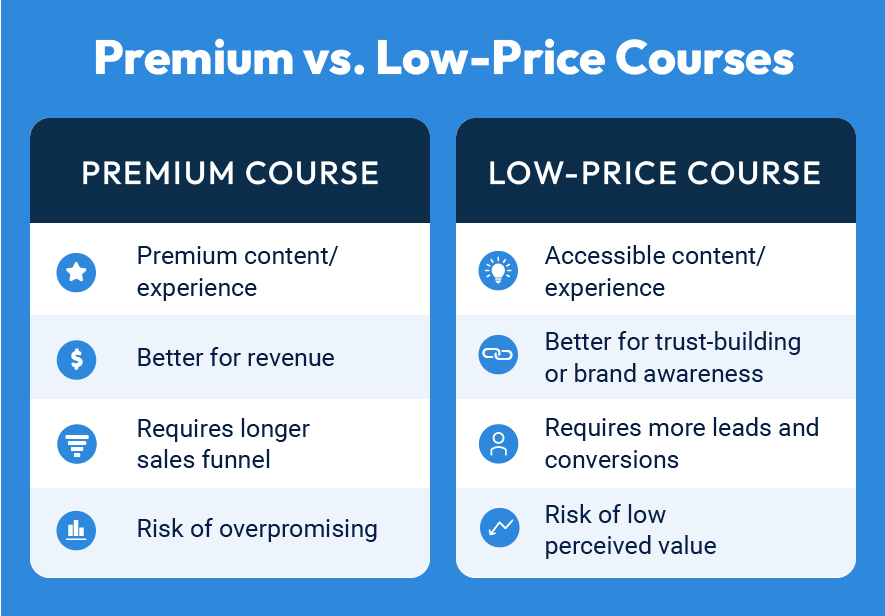
The most important consideration is to charge a price that reflects your course’s worth, but there are a couple of other key factors that determine whether your premium course will actually sell.
The most fundamental rule for charging a high price is to offer premium content and/or a premium experience that is worth a premium price tag. This might seem like an obvious point, but it’s common for content creators to shy away from a higher price point because of doubt or to charge an unnecessarily high price for the sake of brand perception. Both can actually do damage to your brand’s reputation (although it’s better to start lower and gradually increase the price, than the opposite).
You might be geared up to offer a high-quality, high-cost course that you feel is worth it for your students — but will they feel the same way? Deep dive into your ideal client profile and make sure their income level and commitment level align well with the price you chose. “High price” means something different for every audience and every topic.
A premium course doesn’t have to be sold to one individual for one upfront payment (although this is certainly an option). Consider offering payment plans that let students pay in installments, or incentivizing businesses and organizations to pay for your course with group pricing deals.
Higher-priced courses should be marketed differently than low-cost courses. A client needs more trust and commitment to invest in an expensive course. Before you attach a high price tag to your new course, make sure you have a plan for nurturing leads over a long sales cycle.
Set up a persuasive sales page with testimonials, automated email sequences, and anything else your audience might need to make a purchase decision. Pay particular attention to the quality of your leads and not just the quantity. For a premium course to drive revenue, you need to find the perfect clients for your program and then be willing to invest heavily in their journey!
A low price doesn’t guarantee more course sales. So why would you ever sell your course for less than you could? This strategy makes sense when the course has another purpose besides revenue generation.
Revenue isn’t always the best goal for an online course. For example, a fitness coach could use a mini-course as a lead magnet that grows their email list, or a consultant could build trust in their services by offering a high-value course at a great deal. If you don’t need your course to be a big revenue driver, you can get more creative with its goals and pricing.
“Low price” and “high price” are relative terms that depend entirely on your target market and competition. Remember that what feels like an accessible or appealing price to you may not come across the same way to your audience. If you’re selling a course to C-Suite executives, for example, you might want to be careful how low you go. You want to convey that your course is worth their time! Make sure your audience research accounts for your students’ budgets and values.
You may not need a long sales funnel for a low-cost, low-commitment course, but you will need a plan to make this digital product worth your effort. This typically means developing a strategy for consistent lead generation.
A premium course needs minimal leads and conversions to turn a profit from a specific client niche, but a course that’s supposed to build trust or drive sales for other products will need a high level of engagement to make a difference. Your marketing strategy for a course like this should focus on generating a consistent stream of prospects and include a plan for how you will reach new audiences over time.
As you receive feedback or get new ideas, digital products are simple to improve. Here are a few practical ways you can increase the value of your course to drive higher profits:
Kartra’s all in one course platform makes it easy to create an outstanding experience for your students without piling on software subscription fees. As your online course business grows, there are a lot of tools you’ll need to market and manage your courses:
…and the list goes on. Kartra offers all of these features and more — so you can deliver and manage your course from the same platform! Kartra’s full stack of native features will save you the time and costs of stitching together multiple platforms — creating a seamless experience for both you and your students.
In today’s fast-moving business world, picking the right digital platform can make or break your success. Take Ryan Turner from Amplifi Strategy, for example. He went from bootstrapping his online business together, to leveraging intelligent marketing strategies. Ryan’s agency recently generated nearly $20,000 in a single week by repurposing a past marketing campaign and leveraging marketing automations. His story is a powerful reminder that with the right approach and tools, any entrepreneur can take their business to new heights.
Ryan’s enthusiasm for marketing is driven by its unique power to bring people together globally. Originally from America but now residing in Spain, he realized the significance of nurturing online relationships and expanding the reach of both entrepreneurs and companies internationally. This inspired him to establish Amplifi Strategy, an innovative marketing company committed to supporting businesses that make a difference.
Their approach prioritizes strategic thinking over quick-fixes, setting them apart from their competition. They firmly believe that online marketing isn’t one-size-fits-all and that each business and customer is unique.
Ryan’s business was doing well, but he felt stuck.
He was duct-taping a bunch of different tools together, spending a fortune on multiple subscriptions, and manually performing tasks that could have been automated. Because of this, Ryan was limited in his ability to reach new clients and do what mattered most: provide his stellar marketing services. Thankfully, everything changed when he discovered Kartra.
In 2018, Ryan stumbled upon Kartra while surfing the web. As he vividly remembers, “Once I saw what it could do, I knew this was going to be something that could take me really far.” Soon after, he realized that he could consolidate everything he needed into just one platform, waving goodbye to the need for countless software subscriptions. This saved him valuable time and money.
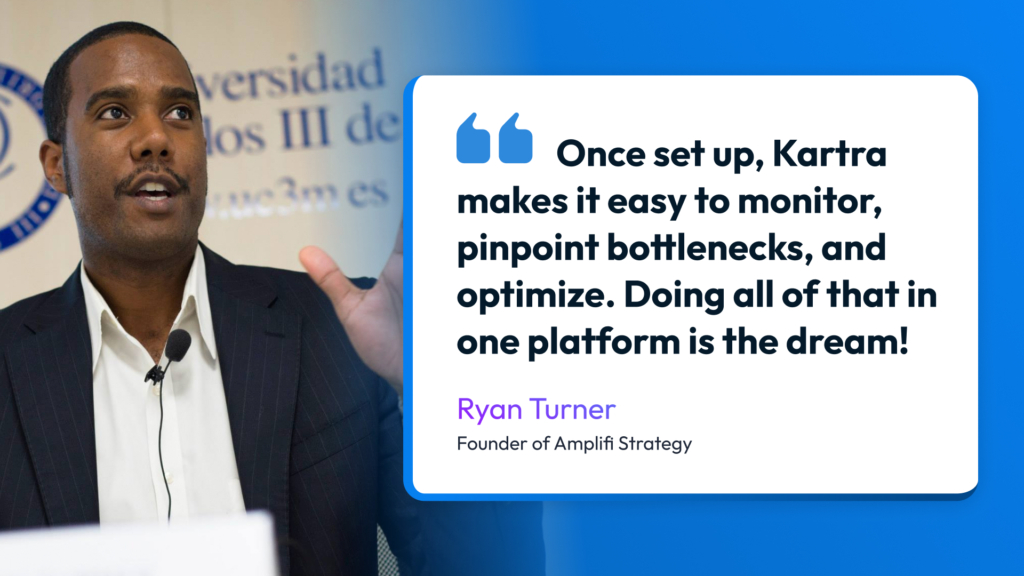
Kartra’s automation features have saved Ryan time, allowing him to focus on scaling his business and those of his clients. This extra time for strategic planning has led to new opportunities.
One of Ryan’s clients, a high-end dog trainer, was doing well before teaming up with Ryan. But the pandemic created a significant challenge, as potential buyers hesitated to spend $8,000 on dog training without a face-to-face meeting.
To adapt, Ryan guided the company in a new direction: instead of training dogs, they shifted to educating dog owners. Leveraging Kartra’s marketing tools and webinars, Ryan helped transform their business model. Within six months, they increased their revenue from around $10K a month to $150K a month by selling an online course. Ryan attributes this major win to intelligent strategy, fueled by Kartra’s infrastructure.

Ryan uses Kartra for a variety of reasons. All-in-One Functionality
With everything from page building to email marketing under one roof, Kartra simplifies Ryan’s online business logistics.
Kartra’s seamless integration allows Ryan to have cohesive marketing strategies without the headache of juggling multiple tools.
Kartra’s robust automation features allowed Ryan to scale his business effortlessly.
Knowledge is power, and Kartra’s analytics provide Ryan invaluable insights for informed decision-making and strategy optimization.
For those hesitant to take the plunge, Ryan offers words of wisdom: “Commit to the journey. Give it the time and dedication it deserves, and watch your business soar.” Success isn’t just about tools; it’s about the mindset and determination to succeed.
Start your 30-day free trial of Kartra today and discover how you can streamline your operations, enhance your branding, and grow your business with the same platform that helped Ryan Turner achieve his incredible success. Let’s grow together.
Artificial intelligence (AI) has revolutionized many facets of our lives, and copywriting is no exception. With the advent of powerful AI tools, tasks like writing emails, website copy, and other marketing materials have become remarkably easy. AI copywriting tools are reshaping how businesses approach content.
In a world of endless marketing demands, AI-powered tools are changing the way we write and create. If you have ever felt frustrated by the time-consuming nature of writing emails or web copy, this new technology will feel revolutionary. AI copywriting tools allow you to tap into the power of artificial intelligence and create high-quality copy in seconds. However, for those new to this technology, an understanding of how it works and how to get the best results can be daunting. Fear not! In this comprehensive guide, we’ll walk you through the basics of AI generation and provide you with valuable tips and best practices for crafting prompts that yield exceptional outcomes.

AI copywriting tools like ChatGPT or Google’s Gemini are called large language models (LLMs). These AI models have been trained on a staggering volume of data, enabling them to understand language patterns, relationships between words, grammar, and styles. These AI tools have become so capable they may even generate text that is often indistinguishable from human-written copy.
When you provide a prompt (an initial instruction or piece of text), the AI model generates a new copy based on your input and its vast knowledge base.
Think of AI copywriting tools as an extremely talented writing assistant who has in-depth knowledge of your topic of choice. To get the best results, you need to give this assistant clear directions. Here’s a simplified analogy:
You have an idea: It’s like deciding, “I want to write about our new product.”
You give instructions (the prompt): The prompt is like telling your assistant, “Okay, I need a friendly email introducing our new product, focus on how it saves customers time.”
The AI assistant does the work: Your AI tool will use its understanding of language and your instructions to draft a suitable email.
With an AI copy generator, you can:


The quality of your prompts directly influences the quality of the AI-produced copy. To achieve the best results from your AI tool, it’s vital to understand how to craft effective prompts. Think of your prompts as blueprints the AI will use to build your materials.
Begin with a clear and concise description of your copy objectives. Avoid ambiguity by outlining specific goals, target audience details, desired tone, and any key points you want to convey. The clearer your instructions, the better your results. Instead of a vague prompt like “Write a blog about marketing,” try “Write a blog post explaining 5 ways AI can improve email marketing click-through rates.”
Context is key, providing sufficient context to guide the AI’s understanding of the subject matter is essential. Briefly introduce the topic, relevant background information, and any specific details necessary for relevance and coherence. Add details like “Target audience is small business owners” or “Our brand voice is friendly and informative.” An example is Kartra AI, which enables users to define these contextual insights within their business setting and then select their desired tone when generating a prompt.
Be precise and detailed in your prompt to facilitate accurate copy generation. Include relevant keywords, key phrases, and specific instructions to align the output with your objectives and preferences. Utilizing keywords will enhance the relevance and SEO-friendliness of your generated copy. Conduct keyword research to identify high-impact terms and integrate them seamlessly into your prompts.
Craft your prompt with the target audience in mind, focus on their demographics, interests, and challenges. While the prompt itself is for the AI, it should encapsulate the audience’s needs and preferences. In doing so, you’ll ensure the AI-generated results are tailored, relevant, and resonate with the intended audience.
Define the desired tone and style of the generated copy. Whether it’s formal, informal, professional, or conversational, specifying the tone helps maintain consistency and reinforces your brand identity.
Don’t hesitate to experiment with different prompts and iterate on the generated output. Experiment with variations, analyze the output, and iterate for improved outcomes.
If you’ve had success with something and want to recreate it, feel free to do so! For example, “Here’s an email we previously sent that was successful, using a similar style.” Then, you can expand on your objectives.
When working with AI tools, the quality of the results you get hinges on the quality of your input – your prompts. Let’s see the difference between good and bad prompts in action:
Bad Prompt: “Write a blog about pet adoption.”
Why it’s bad: This prompt leaves the blog’s angle entirely up to the AI. Is it a personal story? A list of tips? A call to action? There’s no way for the AI to know what style or focus to take.
Good Prompt: “Write a persuasive blog post encouraging first-time pet owners to consider adopting from a shelter. Emphasize the rewards of adoption and address common concerns (cost, existing pets, etc.).”
Why it’s good: This provides a clear structure (persuasive blog post), a specific audience (first-time pet owners), and points to address within the writing (emphasize the rewards of adoption and address common concerns).
Bad Prompt: “Write a product description for my handcrafted jewelry.”
Why it’s bad: This doesn’t offer any guidance on style or tone. Is the jewelry delicate and minimalist or bold and statement-making? Without knowing your brand voice, the AI might produce something unusable.
Good Prompt: “Write a whimsical and playful product description for my handcrafted beaded earrings inspired by nature. Mention they’re lightweight and perfect for summer.”
Why it’s good: This gives the AI stylistic cues (‘whimsical’, ‘playful’), outlines practical information (‘lightweight’), and even provides a seasonal angle (‘summer’).

In addition to crafting effective prompts, adopting best practices can further enhance the efficiency and quality of AI generated copy. To get the most out of your AI copywriting tool, use these strategies:
While AI tools are remarkable, they shouldn’t completely replace human creativity. Use them as powerful assistants. Here’s how to strike a balance:
Crafting powerful prompts is both an art and a science, requiring creativity, precision, and a willingness to learn. As you embark on your journey into the world of AI copywriting, remember that every prompt is an opportunity to unleash your creativity and shape the narrative. With practice, perseverance, and a commitment to excellence, you’ll soon master the craft of prompt generation and harness AI’s transformative potential to create compelling, impactful writing that resonates with your audience. Embrace the journey, and let your imagination soar!

AI copywriting doesn’t replace human writers, rather, it’s a transformative tool that empowers everyone to become more efficient and innovative in their communication. By following the guidance in this article, you’ll be well on your way to effectively harnessing the power of AI to save time, streamline workflows, and produce excellent content.
The Future is Automated
AI integration is an exciting new step in your workflow. As you get familiar with this technology, you’ll unlock new levels of efficiency and productivity. Now, go experiment! Remember, the best way to learn is by doing. It’s important to note that not all AI models are trained on the most up-to-date data. As a result, many AI may have little knowledge of most recent events or may have hallucinations (responses that are incorrect, misleading, or nonsensical).
AI isn’t magic… but it sometimes feels close! While it’s undeniably powerful, the best results come from a blend of AI’s abilities and your human understanding of your business. This partnership is how you’ll achieve truly exceptional results.
Kartra’s AI integration understands the nuance of your business. This understanding allows it to generate copy that perfectly represents your brand, saving you hours while giving your marketing a boost.
Ready to experience the power of personalized, contextually aware AI for your business? Start a free trial of Kartra today and let the AI revolutionize your marketing!
Sometimes the biggest obstacles pave the way for our greatest achievements. Simon Lovell’s story is proof. After facing significant health challenges, he discovered Kartra and transformed not just his business, but his life.
Simon’s journey began in England, but his entrepreneurial spirit led him to San Diego, where he transformed his business approach.
Initially helping personal trainers scale their businesses, Simon’s path took a pivotal turn towards mentoring entrepreneurs, CEOs, Olympians, and even celebrities. His unique Super High Performance process marked the beginning of an extraordinary chapter. But then everything changed.
After battling Covid, Simon was diagnosed with Guam Bere Syndrome, leaving him unable to walk. During his recovery, Simon found solace and strength in pickleball. This discovery wasn’t just a step toward physical rehabilitation. It also sparked a new business venture.
Sensing an underserved but quickly growing niche, Simon created the online community Picklepreneurs. It helps pickleball entrepreneurs scale their business together with coaching and classes.
He had his new business idea, but his current software was causing him problems in marketing it to the world.

Frustrated with the complexities of other marketing platforms, Simon was attracted to Kartra for its streamlined, all-in-one solution. “It was definitely through frustration of just a lot of different things in a lot of different places… one should just simplify,” Simon recalls about his switch to Kartra.
With Kartra, Simon found the streamlined, all-in-one solution he needed. And he never looked back.
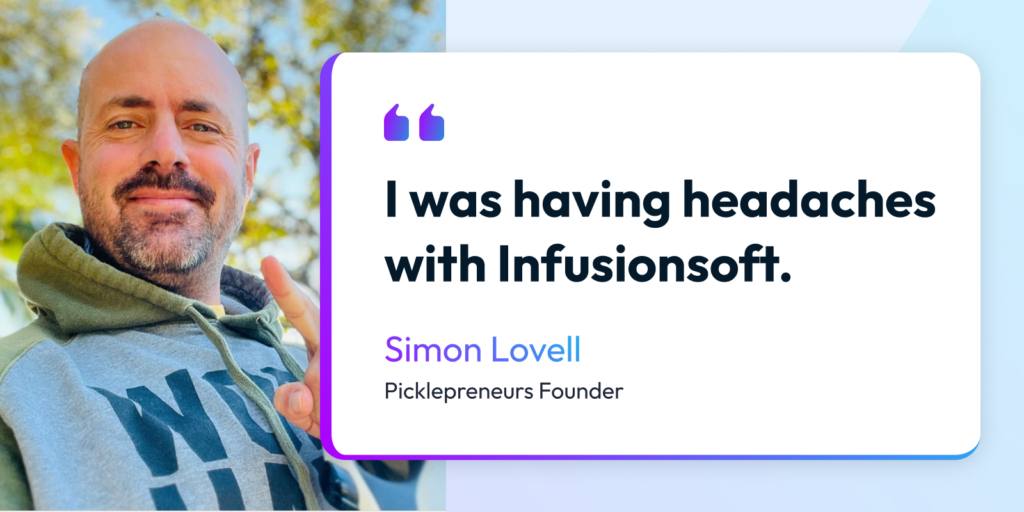
Kartra became the backbone of Simon’s business, allowing him to create compelling personal branding and innovative courses all within one platform.
Through Kartra, Simon not only elevated his own brand but also empowered his clients to achieve unprecedented success.

Simon was impressed by Kartra’s software solution for several reasons:
Kartra’s intuitive design simplified the creation and management of Simon’s marketing campaigns, funnels, and more.
From email marketing to payment processing, Kartra consolidated all the tools Simon needed to run a successful online business.
With customizable templates and integration capabilities, Kartra enabled Simon to showcase his unique brand effortlessly.
Kartra’s automation and tagging features allowed Simon to create high-accountability programs for his members, leading to higher course completion rates and client satisfaction.
By eliminating the need to pay for multiple software platforms, Kartra helped Simon save on overhead costs without sacrificing functionality.
Simon’s innovative use of Kartra has led to significant growth in his business. By optimizing his content after analyzing the data on course completion rates, he improves his clients’ outcomes, which is what his business is all about.
His focus on accountability and client success has not only reduced refunds, but also opened new opportunities for upselling and client retention.
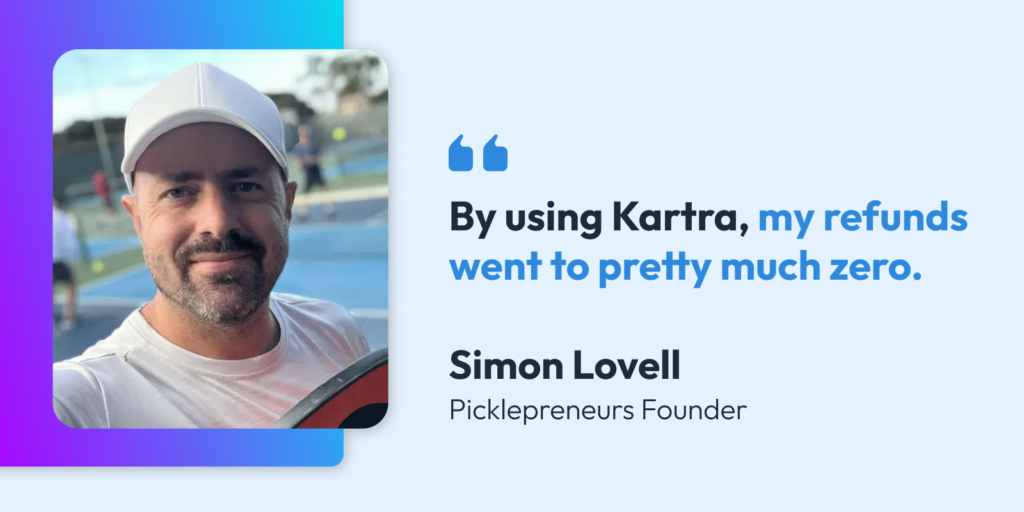
For those considering Kartra, Simon emphasizes the importance of leveraging the Kartra community and support resources to overcome hurdles and accelerate progress.
He offers this sage advice: “Give yourself that free trial period to get as much done as you can and get your stuff out there.”
Simon’s story is more than just a success tale. It’s a blueprint for resilience, innovation, and choosing the right tools. If you’re ready to take your business to new heights, Kartra is here to make it happen.
Start your 30-day free trial of Kartra today and discover how you can streamline your operations, enhance your branding, and grow your business with the same platform that helped Simon Lovell achieve his incredible success. Let’s grow together.
65% of businesses believe generating traffic and leads is their biggest marketing challenge.
That means two-thirds of business owners find acquiring new customers to be more difficult than say, closing the sale or getting people to open their emails (which are not small feats either).
And sure, you could just throw money at Google and Facebook and pray that your ads convert, or take to the streets with a megaphone and a million hand-printed adverts and hope you’re not arrested.
Or, you could try a better method.
A method that means not paying a cent for traffic until AFTER it converts into an actual physical sale. That means spending your time focusing on your business, not your ads.
It’s called affiliate marketing. So if your business is looking to set up an affiliate program or you’re a beginner entrepreneur looking to make some passive income, our guide will help make your affiliate venture successful.
Affiliate marketing is the process of paying others a commission to market your products on your behalf. In the online marketing world, businesses set up a program and invite members to join their affiliate network. Each person who signs up gets a personalized tracking URL. They use this link when promoting your products on their website, social media posts, and other outlets. When people make a purchase using the link, an affiliate marketing system tracks the sales and your affiliate partner receives a percentage of the sale total.
If you’ve ever wondered about setting up an affiliate program, we’ve got good news! Some of the world’s biggest brands and startups are investing heavily in their affiliate programs because affiliate marketing has proven to be successful. The benefits of growing a successful affiliate marketing network are tremendous.
Here are 10 reasons you should consider setting up an affiliate marketing program for your small business:
Most small business owners try their hand at a variety of advertising and digital marketing strategies to promote their products and services. Tactics like search engine optimization (SEO), social media, and pay-per-click advertising (PPC) can all be fruitful in the beginning. But many businesses need more cost-effective ways to scale their brand awareness to new audiences without constantly paying for eyeballs and clicks.
With affiliate marketing, you only pay once a sale is made. This means, that if an affiliate has a kick-butt campaign you’ll end up paying more, but you’ll also earn much more than you pay out, which is the goal.
When you pay for advertising before the sale, you might get lucky with a cost-per-acquisition to you of $5. Or, it could be $329. It varies from sale to sale so you never actually know what you’re getting or what it will cost you until the totals are added up. With affiliate partners, you set a commission rate before the sale is ever made, so you know exactly how much each sale will cost you. Tracking these kinds of metrics is crucial to your business’s long-term success.
Many marketers take a shotgun approach to traffic — they aim in a general direction, shoot their message, and hope they hit someone that will buy. And that’s the exact reason why so many marketing campaigns cost more money than they make. Affiliate marketers are experts at collecting warm leads and creating email marketing campaigns tailored to your target audience. This gives you access to thousands of potential customers you would otherwise spend lots of time and money trying to reach. Finding quality affiliates in your field allows you to expose your company to highly-targeted “free” traffic that is more likely to purchase your product.
Speaking of quality affiliates, one of the perks of going the affiliate route is you can hand-pick everyone you work with. Using Kartra, you can create affiliate questionnaires that screen applicants and ensure everyone promoting your products/services is familiar with it and will represent your brand well. This way you build solid partnerships that promote your company the right way.
Effective SEO is one of those things we all know we need, but most of us don’t really understand how to use it to increase our brand’s online exposure. Fortunately, affiliate marketing is one simple method of increasing you site’s search engine rankings. This happens because each time an affiliate shares a link to your product your site acquires a new “backlink.” Backlinks from affiliate links in blogs, social shares, and affiliate websites help to raise your SEO authority and rank your site for the key products you offer. Ever wonder how Amazon grew so quickly? Their affiliate program sent links to their products all over the internet which search engines noticed and rewarded.
Remember the times Facebook went down? Not only was it annoying to not be able to check what all your “friends” were doing in real-time, but for businesses, it meant your ads were temporarily unavailable.
You might master one marketing platform, but if you’re too reliant on it, it can significantly impact your revenue streams if that platform goes down or changes dramatically.
Affiliate marketers use a variety of marketing efforts to ensure they earn a commission. They email their lists, some are bloggers who utilize SEO and high-quality content to drive traffic, while others prefer PPC (pay per click) like Google and Facebook ads, and more avenues — which ensures you’re covering your marketing bases.
Consumers tend not to trust a business when they say their product is awesome. But they trust influencers. In fact, 2 out of 3 consumers reported they trust an influencer’s opinion of a brand more than the brand itself. Meaning, if your affiliates are well-connected, well-liked and relatable — 61% of people find info from a person “just like them” to be credible or very credible, you have an opportunity for more direct sales. Referrals from your affiliate relationships go a long way toward your success.
Running a small business is no small feat. It requires hours burning the candle at both ends, and late nights that leave you chugging copious amounts of coffee in the morning. But, affiliate marketing can take a big chunk of lead generation off your plate. Of course, managing affiliates does require some oversight, but once you’ve screened your affiliates it can be as simple as waiting for the sales reports to come in.
Have you ever hired a costly staff member (and created additional monthly overhead) in the hopes of growing your business? But maybe they were slow to ramp up… or ineffective and it ended up costing you money instead of earning you money?
Affiliates can fix that problem. Rather than having a salaried marketing team, your affiliates can do the same work with affiliate commissions only being paid out after they’ve been effective and sales start coming in as a direct result of their efforts.
Ever wonder why some of the biggest retailers (think Amazon, eBay) invested heavily in their affiliate marketing programs, even as startups? They knew the value their new affiliate partners would bring.
Word of caution…
Now, we know we just presented you with a buffet of reasons why you need affiliate marketing. But, it’s not always as simple as going out and simply “getting” affiliates.
You need to find people who are qualified in your field. For example, if you run a branding consultation business, you don’t want affiliates who are used to selling hair vitamins. You want business experts that people trust. These make for the best affiliate partners.
Once you do find these people, you want to make sure to screen them and get their tax information. Then you’ll need to provide them with affiliate links so they can sell your products / services and you’ll be able to track which sales are connected to which affiliate partner. You may even want to set up a commission structure, like five sales before you payout commissions, to ensure your affiliates aren’t in it just for a discount on your products / services. Most online businesses think they need dozens of expensive apps and integrations to create a new affiliate program. However, that’s not the case!
Fortunately Kartra manages all of it for you. Kartra even has a built-in affiliate marketplace filled with other Kartra users. Here you can find other related products to promote for some extra cash, while other users are applying to promote your business offerings. And once they apply, you can require a mandatory screening process or automated approval followed by custom conditions, automated payments, and more…
This blog is brought to you by Kartra, the all-in-one online business platform that gives you every essential marketing and sales tool you need to grow your business profitably – from sales pages and product carts to membership sites, help desks, affiliate management and more. To learn how you can quickly and easily leverage Kartra to boost your bottom-line, please visit kartra.com.
To maximize the impact of your email campaigns on engaging your leads and increasing open rates, understanding and implementing a “sunset policy” in email marketing is key. You may be wondering what this term means and how it relates to your email strategy. In this article, we’ll guide you through it step by step!
Imagine you have a garden where you grow beautiful flowers. Over time, some flowers wilt and lose their charm.
In email marketing, a sunset policy is like a maintenance schedule for your garden. It’s a set of guidelines used to remove old and inactive email addresses from your mailing list, so you can care for the blooms that are fresh and vibrant.

Just like you wouldn’t want wilted flowers in your garden, you don’t want inactive or outdated email addresses in your list. In the long term, continuing to send messages to people who don’t open or engage with your mail can harm your deliverability and domain reputation.
Keeping your email list clean and up-to-date is crucial for effective marketing. It helps you focus on people who are genuinely interested in what you have to offer and get maximum value out of every connection.
A sunset policy sets guidelines for identifying and removing inactive subscribers from your email list. These guidelines usually include criteria, like how long a subscriber hasn’t engaged with your emails or how many times your emails have bounced back.
The best policy for you depends on your business niche, how often you send emails, and what makes a contact engaged vs unengaged in your business.
Think about these questions when creating your policy:

You notice that some subscribers haven’t opened your emails in the last six months. Instead of letting these inactive subscribers clutter your list, you decide to implement a sunset policy.
First, you segment your list to identify inactive subscribers and tag the unengaged group.
Then, you send them a re-engagement email offering them a special discount on their next purchase or some other content designed to spur the recipient into action. Those who don’t engage after a certain period (say, 30 days) are removed from your list, keeping it fresh and focused on responsive recipients.
You can do all of this with marketing software that offers streamlined email marketing automation.

By implementing a sunset policy, you ensure that your email marketing efforts are targeted toward people who are genuinely interested, leading to better results and happier subscribers.
Remember, a clean and engaged email list is like a well-tended garden – it blossoms with potential! To learn more about how to use email marketing to catapult growth, click to read more about taking your email strategy to the next level.
This blog is brought to you by Kartra, the all-in-one online business platform that gives you every essential marketing and sales tool you need to grow your business profitably – from sales pages and product carts to membership sites, help desks, affiliate management and more. To learn how you can quickly and easily leverage Kartra to boost your bottom-line, please visit kartra.com.
A lead capture form is essential for every online sales funnel. But it’s not just a practical necessity for getting contact information — it’s a strategic part of your lead generation plan. Your online form needs to be persuasive, easy to use, and integrated with the rest of your sales funnel. Here are seven tips for building an effective lead capture form:
2. Choose the most relevant form placements
4. Add form fields that work for your goals
7. Keep the whole customer journey in mind
A lead capture form is an interactive website element that prompts a user to fill in contact information in exchange for something of value, such as an email newsletter, ebook, or free consultation. A simple lead form might only have fillable fields for a name and email address, while long or multi-step forms require more detailed information from the prospect — such as an address, phone number, or job title.
Every lead capture form is meant to build a list of potential customers for your business. But you’ll need to narrow in on specific goals for your form — based on the type of lead magnet that it offers and where your audience is in the sales funnel.
For example, you might have a top-of-funnel lead magnet meant to build interest in your brand, like a giveaway. The lead capture form would need to be simple, quick to fill out, and optimized to get as many form submissions as possible. On the other hand, a bottom-of-funnel lead magnet, such as a webinar, is meant to attract high-intent prospects. The registration form would need to bring in high-quality leads — not just a high quantity.
Take some time to set goals for your lead capture form and determine how you will track its success. You will need to refer back to those goals in every other step of the form-building process.
Learn how to build a sales funnel in our step-by-step guide for beginners
Sign-up forms can be incorporated just about anywhere on your website — from a service page to a chatbot. For high-value lead magnets like ebooks or webinars, you may want to build a dedicated lead capture page that explains the offer and includes an embedded form. Short sign-up forms are even easier to feature. Subtly embed them in relevant blog posts, or get your audience’s attention with an eye-catching pop-up! With the right video marketing software, you can even feature sign-up forms during a recording.
As you decide on pages for the lead generation form, think through the following questions:
The good news is you can always test different placement options to see what works best. Just make sure you keep a record of how and where your lead form is placed — and how well it performs.
A no-code form builder is the best way to create sign-up forms that you can implement and adapt at any time. (You can also hire a website developer to code custom sign-up forms, but this is expensive and unnecessary for most business owners.)
With pre-designed form templates, it’s easy to create a professional lead capture form in minutes. Just be sure to select a high-quality form builder that includes a wide range of customization options. You’ll want the freedom to choose exactly the right form fields, design, and placement for your audience!
Whether you have a dedicated landing page for your lead capture form or it’s a simple pop-up, the copy needs to be as clear as possible. You only have a moment to keep your users’ attention. Your website visitors need to clearly (and quickly) see what they are being offered, why it is valuable, and what steps they should follow. Be as specific as you can in the heading and call to action in particular.
For example, if your lead magnet is an ebook, the CTA “Download my free ebook” will likely be much more effective than a generic button like “Submit.”
Images or illustrations also help grab your audience’s attention. Depending on the web form’s size and design, you might be able to incorporate a picture of the lead magnet (such as an ebook cover). An image is easy for a website visitor to understand at a glance and builds trust by giving a sneak peek of the lead magnet.
It’s common knowledge that fewer form fields generally result in a higher conversion rate. This makes sense — someone is more likely to engage with your lead form if it asks for less information. But does that strategy align with your goals?
Top-of-funnel lead magnets are meant to drive brand awareness and build an email list. This stage of the funnel benefits from as many sign-ups as possible. You’ll want to only ask for the most essential lead information in the capture form.
If you’re trying to gain middle or bottom-of-funnel leads, it could be more strategic to use a longer form. Not only will you need more detailed information from high-intent sales leads (such as a phone number or address), but the form’s complexity will help ensure you only engage with qualified leads that are worth your time.
As you decide what fields your leads should fill out, keep in mind how the form will integrate with your lead management plan. For example, if you intend to personalize follow-up email sequences using contacts’ names, you might need to specify which name to provide (First? Last? Both?)
Not every industry needs to implement stringent data security measures, but the principle applies to any online business: earn your audience’s trust. Your leads are giving up private information, and it’s important to be clear and respectful about how you will use it!
This could mean linking to your privacy policy at the bottom of the form, displaying a third-party security certification, maintaining GDPR compliance, or simply limiting follow-up communications to only the most relevant content. You want your leads to feel that it was worth it to fill out your form.
When you first create a lead capture form, you have to make a lot of educated guesses — about the design, length, copy, and placement. The only way to know what works is to test it!
A/B testing — also called split testing — takes one element of a sales campaign and runs two variations to see which performs better. Marketers should optimize lead capture forms by testing relevant components, including:
Just make sure that you have enough engagement to run an effective A/B test, you test only one variable at a time, and you have the necessary analytics software to measure results.
Learn more in our guide on how to run A/B tests to improve your marketing plan
It’s easy to get caught up in top-of-funnel marketing efforts, focusing on lead generation and filling your sales pipeline. But without the rest of the customer journey built out, you might find yourself with tons of new leads and few conversions. Your lead capture form should work alongside the rest of your sales funnel to create a compelling and intuitive customer journey.
For example, the form design and copy should align with your brand image and messaging. The form fields should integrate seamlessly with your CRM or lead management software. And any automated workflows — such as follow-up email sequences — should be tailored to the needs of the specific audience who’s engaging with your lead forms.
It’s possible to create sales funnels by piecing together multiple platforms like a form builder, email marketing software, and lead management software. But is it smart? A comprehensive marketing platform that offers all these features saves business owners time and money (integrations add up).
More importantly, an all in one platform streamlines the entire funnel-building process – freeing you up to focus on optimizing your campaigns instead of fixing errors.
With a quality all in one platform like Kartra, business owners can…
Lead capture forms are just one part of the sales process. For your lead generation strategy to drive revenue, you’ll need the right tool to manage the whole customer journey!
Kartra’s all in one marketing features enable you to connect your entire sales pipeline
This blog is brought to you by Kartra, the all-in-one online business platform that gives you every essential marketing and sales tool you need to grow your business profitably – from sales pages and product carts to membership sites, help desks, affiliate management and more. To learn how you can quickly and easily leverage Kartra to boost your bottom-line, please visit kartra.com.
Wouldn’t it be great if you could create a business from home and scale it to nearly $2.5 million a year, all in one platform? It’s not a dream. It’s the reality that Dominick Pirone discovered with Kartra.
Dominick isn’t just any DJ business owner. He’s built a thriving online community of DJs who are passionate about their craft. Pirone has created a subscription-based online membership for DJs, where they can find resources for music preparation, gig booking, and skill enhancement.
But his business wasn’t always like this…
Before Dominick found Kartra, he was burned out and frustrated.
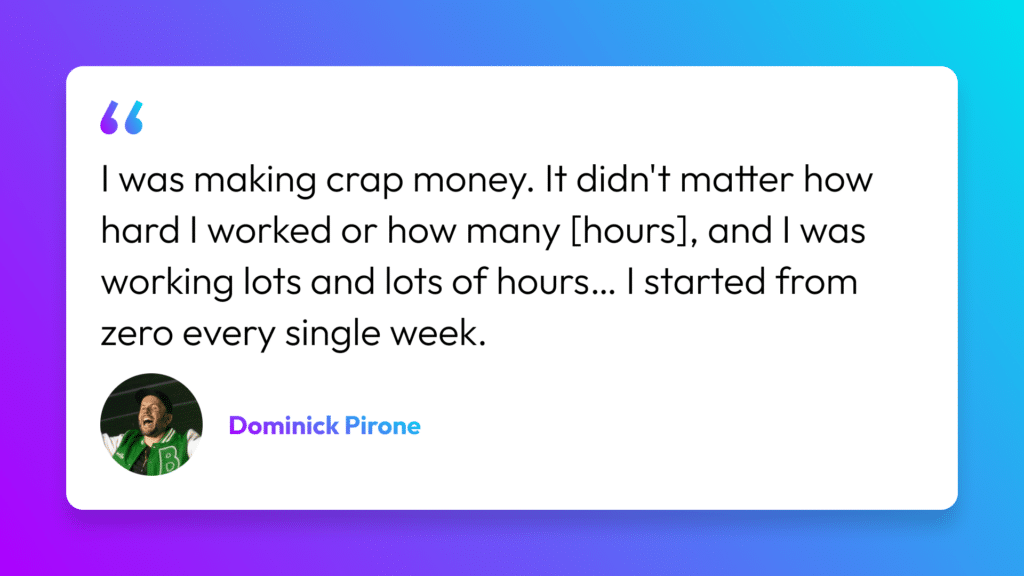
At just the right time, he was introduced to DJing by his brother, who was making great money and having fun doing it. This inspired Dominick to try his hand at DJing, too. As their business gained momentum, Dominick and his brother started wondering how they could sell their expertise online.
In his quest to grow his DJ business online, Dominick stumbled upon Kartra and quickly realized its potential. Unlike other platforms that offered partial solutions, Kartra brought everything he needed under one roof, simplifying his workflow.
For Dominick, Kartra was a revelation with its ability to create endless streams of online income, put almost any business task on autopilot, and send personalized marketing messages to each of his subscribers based on their engagement. Kartra’s advanced analytics tools were crucial in understanding customer behavior and refining marketing strategies, too. All in all, the platform became his go-to for business growth.
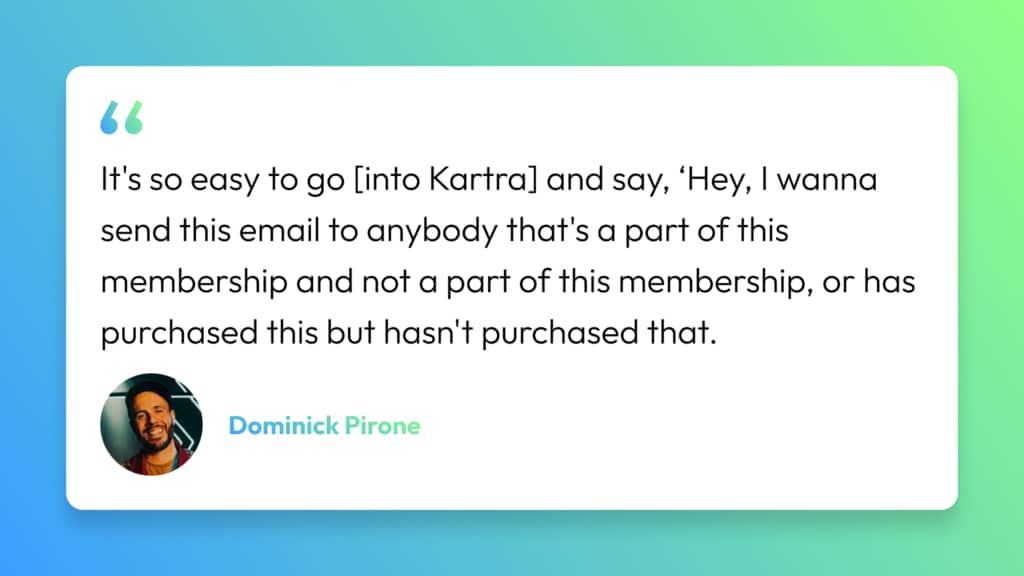
With Kartra, Dominick seamlessly integrated email marketing, membership management, and payment processing, saving time and enhancing efficiency.
Kartra’s membership site features allowed Dominick to nurture his community of DJs, offering personalized experiences and fostering connections.
Kartra’s Behavioral Adaptive Marketing (BAM) allows you to send unique messages to your leads based on the content they engage with, or the pages they visit. This feature empowered Dominick to create highly personalized marketing strategies that run on autopilot, leading to increased engagement in less time.
Dominick tapped into Kartra’s comprehensive analytics, gaining valuable insights that shaped his marketing strategies and business decisions.
With Kartra, managing and optimizing sales funnels became more efficient, significantly enhancing Dominick’s ability to convert leads into dedicated customers.
Incorporating Kartra into his business was a turning point for Dominick. Its ability to tailor experiences to individual member needs was a key factor in boosting retention and engagement.
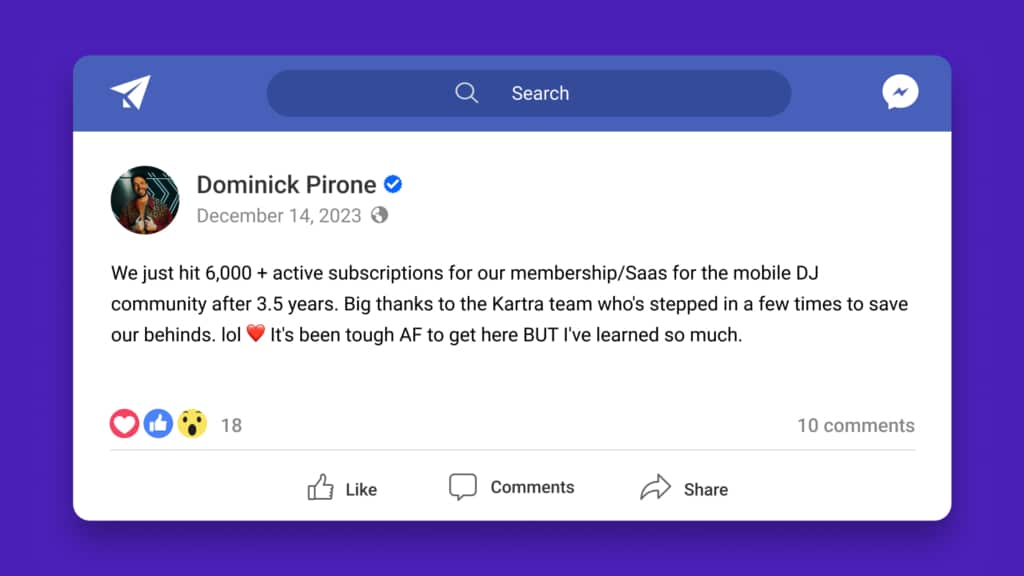
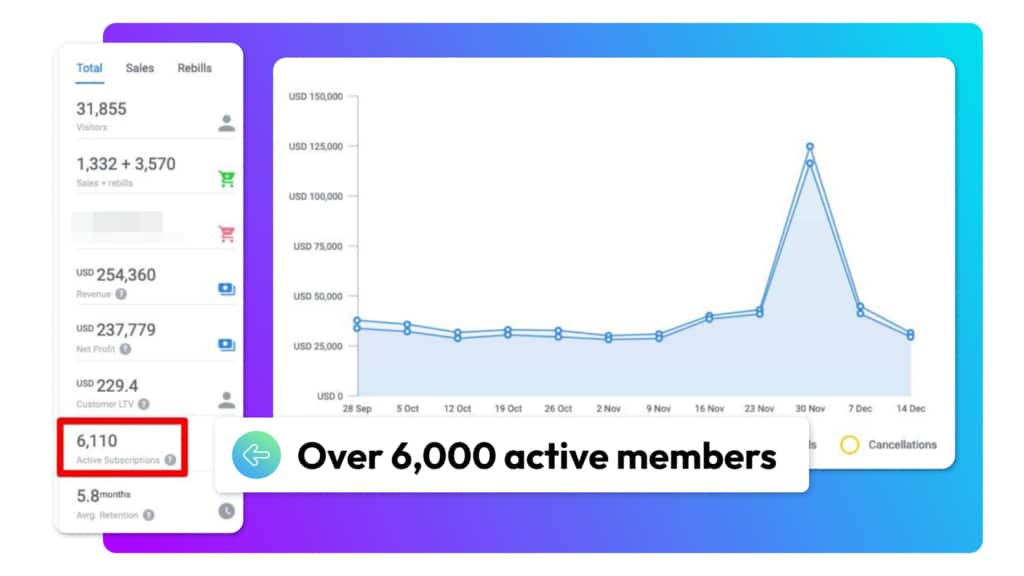
His membership numbers skyrocketed from 30 to over 6,000 members, thanks to Kartra’s scalability and advanced features. And Dominick recently reached a new record: generating $254,360 in one month. He’s now on track to gross $2.5 million for the year!
Dominick credits much of his incredible success to Kartra’s versatility. His advice? Focus on mastering one funnel or membership at a time for more impactful results. Embrace the power of challenges and webinars to enhance member engagement and boost sales.
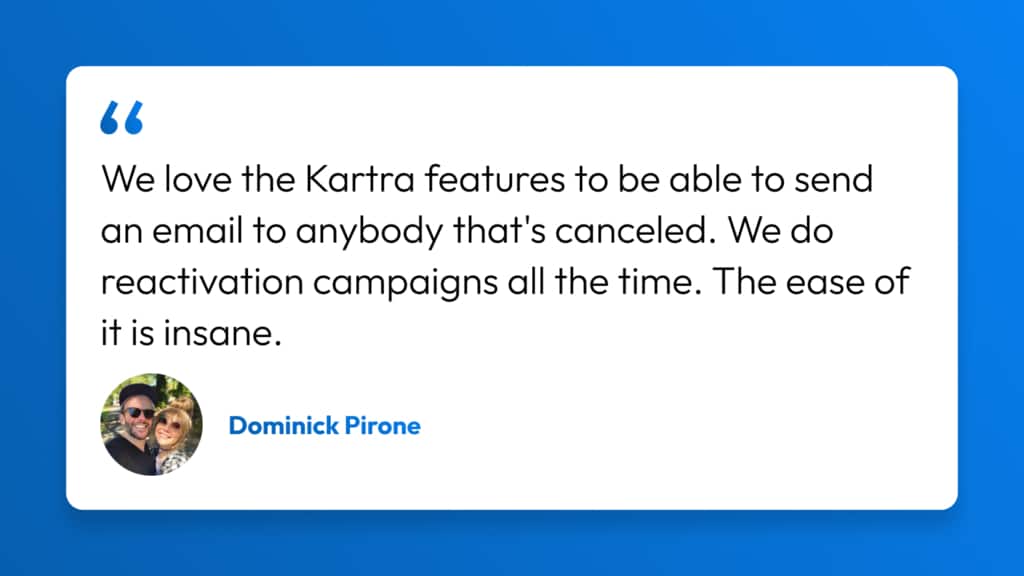
Imagine a tool that simplifies your business processes while amplifying your growth – that’s Kartra. Whether you’re a coach, consultant, or expert, Kartra is your ally in creating a thriving online presence that’s manageable, scalable, and profitable.
Are you ready to experience how Kartra can remix your business?
This blog is brought to you by Kartra, the all-in-one online business platform that gives you every essential marketing and sales tool you need to grow your business profitably – from sales pages and product carts to membership sites, help desks, affiliate management and more. To learn how you can quickly and easily leverage Kartra to boost your bottom-line, please visit kartra.com.